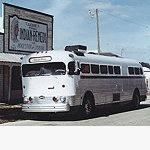| Author | Message | ||
| Stephen Fessenden (Sffess)
Registered Member Username: Sffess Post Number: 722 Registered: 1-2002 Posted From: 66.38.120.219 Rating: N/A |
Can someone help me find information on the types of Pex pipe. There are Pex A, Pex B and Pex C besides aluminum pex. I need to do some home plumbing and I cannot find a website with information to help in makeing the decision on which type to use. I also need to replace one line on the bus, so it is a bus topic also. Thanks, | ||
| George M. Todd (George_mc6)
Registered Member Username: George_mc6 Post Number: 371 Registered: 8-2006 Posted From: 207.231.75.253 Rating: N/A |
Steve, PEX (cross-linked polyethylene) is made in a couple of types, and then there is the aluminum type. One type is made with an oxygen barrier, which is used for closed-loop heating systems, the standard stuff which is used for potable water, is available in white, blue and red, which is neat. Then there is the orange colored aluminum sandwich brand, Kitek. All pex requires an installation tool to expand the pipe and collar to fit over the fitting, then the memory causes the pipe to shrink onto the fitting. The only tricks are to turn the tool betwen squeezes so it makes scores all around, and not hold the pipe expanded too long before releasing the tool and inserting the fitting. Needless to say, be ready to insert the fitting in the pipe as soon as you release the tool, or the pipe will grab the fitting halfway in, which isn't good. If that happens, just cut off the collar, and the fitting will probably pull out, then do it again with a new collar. Kitek requires a crimping type tool and steel collars, and in my opinion, is a little harder to work with. Give the pex an hour or so to really get a grip before applying pressure. HTH, George | ||
| David Evans (Dmd)
Registered Member Username: Dmd Post Number: 226 Registered: 10-2004 Posted From: 72.89.123.36  Rating: N/A |
Steve, get pex marked for potable water or barrier pex. Its not as flexible as you think but you can gently make bends and sweeps. There are alot of long radius bends and asst. fittings for pex. We use the tool that crimps the bands. The tool runs about 70.00 Its a locking pliar that wont release until the full crimp is made. carefull of putting the pex into a tight spot where you cant get the open handle of the tool into or cant squeeze it shut such as a small opening under a cabinet. Agood plumbing supply will be able to help. Just be advised one drawback i have seen with the pex is rodents like the pex. I dont have any experience with the tool that expands the pex first. | ||
| Paul Lawry (Dreamscape)
Registered Member Username: Dreamscape Post Number: 219 Registered: 5-2007 Posted From: 12.187.235.66  Rating: N/A |
Stephen, Found this link, don't know if it will help or not. http://www.flair-it.com/ | ||
| Cindy and John (Cindyandjohn)
Registered Member Username: Cindyandjohn Post Number: 59 Registered: 1-2007 Posted From: 70.15.55.179 Rating: N/A |
Stephen, if you dont want to go the crimp on route for the PEX there are some great fittings called shark bite connectors - they are a compression fitting. They work awesome. i used them on our bus and had no leaks or other issues realted to them. they are removable - so if you need to make adjustments later on - no problem. They are a bit expensive, especially if you are doing a whole water system - but the ease of installation, in my opinion, outways the price. John | ||
| Gus Causbie (Gusc)
Registered Member Username: Gusc Post Number: 602 Registered: 11-2005 Posted From: 208.54.200.9 Rating: N/A |
Why can't regular hose clamps be used on PEX plastic tubing? This seems to be the best way to go for just a few connections. | ||
| George M. Todd (George_mc6)
Registered Member Username: George_mc6 Post Number: 372 Registered: 8-2006 Posted From: 207.231.75.253 Rating: N/A |
Dave is talking about Kitek, and Gus hasn't tried to put a pex fitting into pex pipe without expanding the pipe first! A hand pex expander tool doesn't take up much space. G | ||
| Jerry Liebler (Jerry_liebler)
Registered Member Username: Jerry_liebler Post Number: 330 Registered: 3-2005 Posted From: 67.140.170.200 Rating: N/A |
I'm surprised that there even is a pex 'expander'. I did my whole bus fresh water system & used about 85 ea. 1/2" clamps and 90 ea. 3/4" clamps. I used the narrow stainless steel clamps. I used the brass barb fittings and they all slid right into the cut pex ends with gentle pressure & no expander tool. Regards Jerry 4107 1120 | ||
| Jerry Liebler (Jerry_liebler)
Registered Member Username: Jerry_liebler Post Number: 331 Registered: 3-2005 Posted From: 67.140.170.200 Rating: N/A |
Gus, I really doubt that a "hose" clamp will put enough pressure on a pex pipe to seal it. It takes considerable force to crimp the clamps designed for pex and they do definitely 'extrude' the material into the barbs of the fitting. Regards Jerry 4107 1120 | ||
| Jerry Liebler (Jerry_liebler)
Registered Member Username: Jerry_liebler Post Number: 332 Registered: 3-2005 Posted From: 67.140.170.200 Rating: N/A |
I just did a little research and found that there are 3, or possibly more, popular connection systems for Pex plumbing systems. Each connection system has specific fittings, tools and techniques. One uses an expander with rings tools and fittings designed to work together. The basic expander tool costs in the vicinity of $280. Another system uses rings which are compressed around the tube after it has been slipped over a barbed fitting. Two different ring types are used, one uses copper rings and requires a seperate crimp tool for each tube size, another uses a stainless steel ring and one crimp tool works with several tube sizes (this is the system I chose) The stainless rings are a bit more costly but only one $80 crimp tool is needed. The third type of connection system is 'compression' it requires to special tools but the fittings are much more costly. The 'shark bite' sustem is most like the compression and is even more costly. Any of these connection systems work with 'plain' pex tube in either potable water or heating systems but only compression or 'shark bite' should be used with the oxygen barrier tubing in hydronic applications. Regards Jerry 4107 1120 | ||
| Gus Causbie (Gusc)
Registered Member Username: Gusc Post Number: 605 Registered: 11-2005 Posted From: 208.54.200.202 Rating: N/A |
I wasn't aware until after I visited some of the PEX links that there was a pex pipe, I thought it was all plastic tubing. Obviously a hose clamp can't crimp a metal tube very much, or maybe I still don't understand the system. My bus was originally plumbed with translucent plastic tubing and solid copper rings. This system does not seem to exactly fit any of the pex types I read about so it may be something else. I just assumed that pex is the only one using solid rings for clamping. I see no reason hose clamps won't work in my system. | ||
| john w. roan (Chessie4905)
Registered Member Username: Chessie4905 Post Number: 900 Registered: 10-2003 Posted From: 71.58.48.5  Rating: N/A |
I would think that regular hose clamps might strip out before getting tight enough on small plastic tubing. But, it cant hurt to try it. Depends a lot on softness of tubing and fitting/ pressure. They use hose clamps on plastic water lines for wells around here with a multiple barbed fitting and semi-rigid plastic pipe. It works ok. It might work alright because the tubing is a lot larger with larger clampsCheck McMaster-Carr web site; they may list a clamp that would work better. I would think that a clamp like the Japanese cars use with the twin wound wire and screw setup might work ok. They also list a lot of different tubing styles. | ||
| Gus Causbie (Gusc)
Registered Member Username: Gusc Post Number: 607 Registered: 11-2005 Posted From: 208.54.200.54 Rating: N/A |
I really wonder now just exactly what kind of plastic tubing my bus has. I'm beginning to think it is not pex but don't know how to identify it since it is pretty old. | ||
| David Evans (Dmd)
Registered Member Username: Dmd Post Number: 227 Registered: 10-2004 Posted From: 72.89.123.36  Rating: N/A |
Hi Gus, there are several brands of clear tubing, they usually arent used for potable or drinking water anymore. They were for a while in boats but they found if its exposed to any sunlight it can grow the green stuff inside. I never saw any with copper bands but for a while there in the boat industry there was a new player every season.The push locks, cone and ring, oring types with lock clips and on and on. You can use hose clamps but i would use the smaller one and use a nut driver or socket to tighten them. the lock rings once crimped cant get loose hose clamps can after awhile altho i dont think on a pressure water system it would be a big deal. They usually arent over 40psi. Pex is rated at 100psi at 180degrees higher pressures at lower temps.Just remember everyone to use the barrier pex only for heat or potable water use. It has a shiny color in red the regular is a dull red but it all is well marked. | ||
| John D'Amato (Crazydog)
Registered Member Username: Crazydog Post Number: 7 Registered: 2-2008 Posted From: 142.32.208.234 Rating: N/A |
I recently finished plumbing my new home with pex, both for potable water and an in-floor heat system. The fittings all slipped right on with no hassle and a $50 crimper that resembles a pair of vice grips is used for the pex collars. Unless you are doing a LOT the smaller crimper works great and it's handy to have your own for repairs etc. You can rent a heavy duty crimper at most stores that sell the tubing and the larger crimper requires less pressure, but can be a bit of a pain in tighter places. Believe me, plumbing with PEX is dead simple; just get the right tubing and collars for the job, and away you go. Cheers john | ||
| Tim Brandt (Timb)
Registered Member Username: Timb Post Number: 132 Registered: 10-2003 Posted From: 66.165.176.60  Rating: N/A |
Anybody care to guess what I have? It's grey with copper collars. I need to tie into it as someone cut them off in the bay with a sawsall prior to me purchaisng the bus Thanks | ||
| niles steckbauer (Niles500)
Registered Member Username: Niles500 Post Number: 826 Registered: 11-2004 Posted From: 71.42.167.154 Rating: N/A |
Could you be talking about Polybutyl Pipe? http://www.polybutylene.com/poly.html | ||
| Tim Brandt (Timb)
Registered Member Username: Timb Post Number: 133 Registered: 10-2003 Posted From: 74.244.14.221  Rating: N/A |
Yeah that looks like the stuff. Just my luck  | ||
| john w. roan (Chessie4905)
Registered Member Username: Chessie4905 Post Number: 905 Registered: 10-2003 Posted From: 71.58.48.5  Rating: N/A |
Well at least the lawyers made out on the lawsuits. My 4905 has that tubing and copper rings also. I'm not worried as the pressure is a lot lower than residential systems and I'm sure the clorene level is probably higher there. | ||
| Glenn Williams (Glenn)
Registered Member Username: Glenn Post Number: 137 Registered: 6-2006 Posted From: 216.163.57.205  Rating: N/A |
Great post! I was going to recycle some of the freshwater plumbing from a 1995 travel trailer, but it's grey with copper clamps... oh well! Does anyone know if the copper fittings from polybutylene fit pex tube or other stuff? I'd love to reuse it. Thanks! | ||
| John D'Amato (Crazydog)
Registered Member Username: Crazydog Post Number: 8 Registered: 2-2008 Posted From: 142.32.208.234 Rating: N/A |
Hi Glenn, Are you sure they are clamps and not just pressure fittings? Once the PEX clamps are on the only way they come off is to be cut off. | ||
| Patrick levenson (Zubzub)
Registered Member Username: Zubzub Post Number: 24 Registered: 5-2007 Posted From: 74.59.81.77 Rating: N/A |
there are a bunch if different systems out there, use the one that works for you. you can always use an adapter to go from one type to another. Also no problem using pipe clamps in exposed settings (although I doubt pipe clamps are strong enough to clamp pexn onto a fitting securely), I would not suggest them in areas you will not be able to tighten them. I use the black crimp rings that need a special crimping tool to be crimped. I have plumbed many a home with this stuff. It's amazing to do all the supply lines for a house, some in crawl spaces etc in 2 days...and not have a single one leak. Can't do that with sweated copper, at least i can't. | ||
| Stephen Fessenden (Sffess)
Registered Member Username: Sffess Post Number: 726 Registered: 1-2002 Posted From: 66.38.120.219 Rating: N/A |
The following link has a free 128 page pex design and installation manual. http://www.toolbase.org/Design-Construction-Guides/Plumbing/pex-design-guide I finally found the answer to my original question. The manual states that PEX-A, PEX-B, and PEX-C are a European terminology for the three crosslink technologies used and are not related to any rating system. All PEX pipe must meet the same standards even no matter what the manufacturing method. |